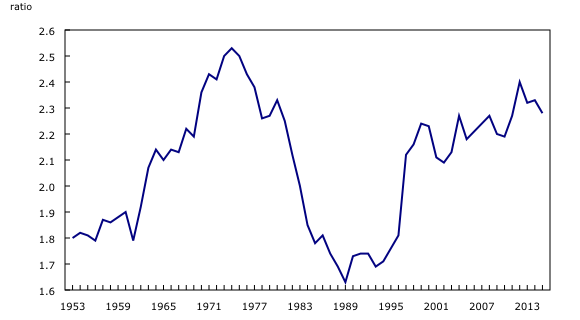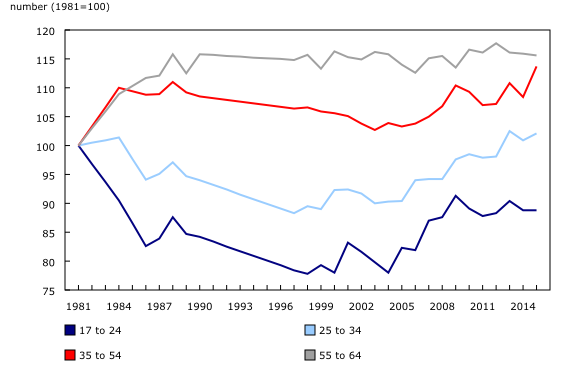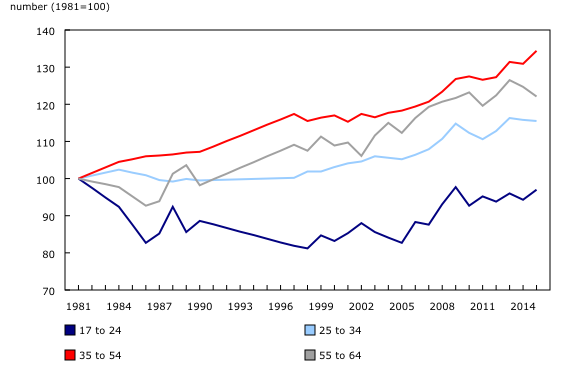Perspectives on the Youth Labour Market in Canada, 1976 to 2015
Archived Content
Information identified as archived is provided for reference, research or recordkeeping purposes. It is not subject to the Government of Canada Web Standards and has not been altered or updated since it was archived. Please "contact us" to request a format other than those available.
Released: 2016-12-05
While youth unemployment in recent years stood at levels comparable to those of the mid-1970s, the proportion of youth employed in full-time or permanent jobs has fallen substantially over the last four decades, a trend also observed in many Organisation for Economic Co-operation and Development (OECD) countries.
The unemployment rate of youth—individuals aged 15 to 24—averaged 13.2% in 2015, slightly higher than the rate of 12.4% observed in 1976. Canada's youth unemployment rate was slightly lower than the OECD average for this group at 14.0% in 2015.
In both 1976 and 2015, the youth unemployment rate was about 2.3 times higher than the rate among individuals aged 25 and older. Over the 1953-to-2015 period, the youth unemployment rate was 2.1 times higher on average.
But while the youth unemployment rate is comparable with levels observed during the mid-1970s, the degree to which young Canadians hold full-time jobs or permanent jobs has changed markedly over the last four decades.
Of all young individuals who are not full-time students, proportionately fewer are now employed full time—that is, in jobs that involve at least 30 work hours per week—than they were four decades ago. Among those who are employed full time, a greater percentage hold temporary jobs.
From 1976 to 1978, the full-time employment rate—the percentage of the population with a full-time job—averaged 76% for men aged 17 to 24 and 58% for women in the same age group who were not in school full time. By the mid-2010s, that is from the beginning of 2014 to the third quarter of 2016, the corresponding percentages were 59% for men and 49% for women.
The drop in youth full-time employment rates was already apparent in the late 1990s and thus originated long before the 2008-2009 recession.
The decline in full-time employment among youth has been widespread and substantial. From the late 1970s to the mid-2010s, the full-time employment rates of men aged 17 to 24 fell by between 9 and 24 percentage points in every province except Newfoundland and Labrador.
The full-time employment rates of young women declined by between 8 and 15 percentage points in the four most populous provinces of Quebec, Ontario, Alberta and British Columbia. Young women in New Brunswick, Prince Edward Island and Newfoundland and Labrador saw their full-time employment rate rise by between 5 and 10 percentage points.
In an accounting sense, the decline in youth full-time employment rates was driven mainly by increases in the incidence of part-time employment rather than by decreases in youth labour force participation or increases in youth unemployment.
Among men aged 25 to 34, the full-time employment rate nationwide declined from 90% in the late 1970s to 81% in the mid-2010s. Among women in the same age group, full-time employment rates increased from 42% to 65%, the result of rising labour force participation.
As proportionately fewer youth landed full-time jobs, those who did increasingly became employed in temporary jobs. Of all men under the age of 25 who were employed full time in 1989—the first year for which data on temporary employment are available—7% held temporary jobs. By the mid-2010s, that percentage had risen to 24%, mainly as a result of a sharp increase in temporary employment during the 1990s.
The corresponding percentages for young women were 8% in 1989 and 26% in the mid-2010s. Again, full-time students are excluded from these figures.
Full-time workers aged 25 to 34 also experienced an increase in temporary employment, although to a lesser extent than their younger counterparts.
These changes in job types were not unique to Canada. In many OECD countries, the prevalence of part-time and temporary jobs as a share of total employment has risen since the mid-1980s.
Changes not unique to youth
The drop in full-time employment rates is not unique to youth. Men aged 35 to 54 also experienced a decline in their full-time employment rate.
Nationwide, the share of men aged 35 to 54 employed in full-time jobs fell from 89% in the late 1970s to 82% in the mid-2010s. This mainly reflected increases in part-time employment and decreases in labour force participation.
Men aged 35 to 54 living in the four most populous provinces of Quebec, Ontario, Alberta and British Columbia saw their full-time employment rates drop by between 4 and 9 percentage points over the period.
For those who had full-time jobs, temporary employment at the national level increased from 2% in 1989 to 7% in the mid-2010s. The corresponding percentages for their female counterparts were 3% in 1989 and 6% in the mid-2010s.
Unlike men aged 35 to 54, women in the same age group actually experienced an increase in their full-time employment rate. In the mid-2010s, 64% had a full-time job, up from 37% during the late 1970s.
Overall increases in full-time employment rates for women more than offset the declines observed among men. As a result, the percentage of the total population aged 17 to 64 employed full-time grew from 62% in the late 1970s to 66% in the mid-2010s.
Evolution of wages
While individuals under the age of 25 became increasingly employed in part-time and temporary jobs, those employed full-time saw their wages vary substantially over the last four decades.
From the early 1980s to the early 1990s, full-time male employees aged 17 to 24 saw their median real hourly wages drop by roughly 15%, while women in the same age group experienced a 10% decline. From the early 1990s to 2004, their median pay rates did not rise.
From 2004 to 2009, their median real hourly wages grew significantly as oil prices increased, the housing boom intensified and general economic activity grew significantly over much of this period.
However, these wage gains did not fully offset the wage losses experienced during the 1980s. The net result was that by 2015, young full-time male employees had median wages that were about 10% lower than those of their counterparts in the early 1980s. For females, the difference was 3%.
Full-time male employees aged 25 to 34 experienced more moderate wage losses during the 1980s. By 2015, their median real hourly wages were fairly similar to those earned by their counterparts in the early 1980s.
In contrast, women aged 25 to 34 employed full time saw their median wages rise by 16% over the period, in part reflecting strong growth in educational attainment and their move to better-paying occupations.
Full-time female employees aged 35 to 54 experienced even stronger wage growth. Their median pay rates grew by 34% from the early 1980s to 2015. Meanwhile, their male counterparts saw their wages rise by 14%.
Overall, the median wages of full-time employees aged 17 to 64 grew by 16% from 1981 to 2015, with two-thirds of the growth occurring after 2004.
Products
The product "Perspectives on the Youth Labour Market in Canada" (11-631-X), is now available.
Contact information
For more information contact us (toll-free 1-800-263-1136; 514-283-8300; STATCAN.infostats-infostats.STATCAN@canada.ca).
To enquire about the concepts, methods or data quality of this release, contact René Morissette (613-951-3608; rene.morissette@canada.ca), Social Analysis and Modelling Division.
- Date modified:




